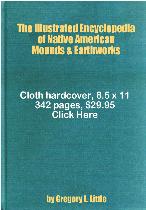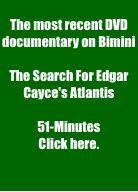Report On The Search For Florida's Underwater Pyramids by Dr. Greg Little Last issue of AP I announced that we were finally going to conduct a search for the alleged underwater pyramids off the east coast of Florida, especially focusing on the area off Vero Beach. The project took place between December 28, 2008 and January 2, 2009. Those directly involved—other than myself—included Dr. Lora Little, the Bahamanian dive master and boat captain Krista Brown, and actor/filmmaker Stan Prachniak. John Van Auken and Doris Van Auken of the ARE were also present during portions of the project. One important reason the search was conducted was that the waters in the area are usually choppy and the waves are often large. The winds sometimes reached over 30 mph and we were briefly swamped and completely soaked at least one time by large waves. We spent one day on the water when a "small craft advisory" had been issued by the National Weather Service. However, it has to be explained that this was the actual plan as we were running a new boat through tests and intended to assess its capabilities. The boat will be used for extensive exploration and we wanted the initial tests to be severe. Prior to going to the area we obtained a precise description on the location of the alleged structure, first reported by Captain Buster Conway in the early 1980's. Brent Raynes interviewed one of Capt. Conway's close friends, Dr. Berthold E. Schwarz, an eminent semi-retired psychiatrist now living in Vero Beach, who provided numerous details about the pyramid story. There also are some sketchy internet reports from individuals claiming to have stood on the structure, but all of these reports I consider to be questionable. From those descriptions I tend to think that the individuals were standing on a manmade reef offshore of Vero Beach. The reef is made from thousands of square limestone blocks. As I wrote in last month's article, "Logically, it would seem obvious that since the 1980's someone would certainly have refound this alleged structure if it existed. Nevertheless, we plan on doing a full and systematic search of the area with both the side-scan sonar and a continual video feed." Dr. Schwarz revealed to Brent Raynes that Buster Conway was reliable and sincere about his claim and I have no reason to doubt that assessment. I have known Dr. Schwarz for over two decades. Dr. Schwarz added that others had tried to find the structure but the murkiness of the water prohibited anyone from relocating it. In addition, Conway himself had tried to refind the structure several times without success. The general location of the structure is a few miles offshore from a host of Spanish treasure ships that were destroyed during a hurricane in 1717. Krista Brown and I scuba dived near a reef but the underwater visibility was actually less than 2-feet. The underwater video proved useless in the murky water but the sidescan sonar was flawless. Our sidescan sonar easily detected a host of ship ballast, reef structure, and coral formations. Starting about 200 yards from the shoreline, we made several 3-mile runs utilizing the side scan sonar with the bottom contours and anything on the bottom shown in remarkably vivid detail. These 3-mile runs were done in a pattern that allowed us to eventually look at an area approximately 2-miles wide and 3-miles long with the 3-mile side going into the deep water to the east of the coastline. What we essentially found was nothing whatsoever except for a smooth sandy bottom and an occasional object—such as a tire— laying on the bottom. The result of this search, which in science is called "negative results," simply means we found no evidence of the alleged pyramid structure. It does not mean the alleged structure does not exist. While we focused our search on the exact area where the structure is supposedly located, there are a host of possibilities that might account for the finding—or lack of finding. First, something resembling a pyramid could be there, but the location might simply be outside the area we searched. However, as mentioned earlier there is an unusual reef near the shoreline—portions of which are manmade and constructed of cubic limestone blocks—that could account for some of the more recent accounts of the structure posted on the internet. A more likely explanation is that there are unusual limestone outcrops found on the bottom in the general area—although not in the area we searched. These outcrops resemble cones, spires, and steeples and are described on marine charts by those terms. However, most of these are in much deeper water and some are simply too far away to have been confused with this area. Personally, I not believe that a pyramid is there, but I do believe that Buster Conway probably saw something that he interpreted as a pyramid. Because he could not later refind the structure, I tend to believe that he was confused about the location. And so, the mystery of the alleged pyramids has been systematically probed for the first time, at least to some extent, but it remains unsolved. Contrary to claims made by others, the supposed location of the pyramid is actually dived seldom—if ever. Dive operations that do visit that area of Florida usually go to deeper sites often tens of miles from the location. Divers do visit the Spanish galleon wrecks located just off shore in shallow water in the summer. Because we had been given the precise location of Conway's pyramid site we focused our efforts there rather than trying to find the completely obscure sites of other alleged pyramids further up the coast. Those reports do seem to fit the locations of the unusual but natural "cones" and "steeples" off the coast. These are heavily visited by fishermen and some would, indeed, have the appearance of pyramids on depth finders and sonar. Florida Mound Site & Canal Visit: The ARE Report During the trip to Florida the entire team visited the unusual Ortona Mound site, located to the southwest of Lake Okeechobee. The site has numerous linear and geometric mounds and is the site of an unusual canal system made by the ancient Native American tribes inhabiting the area during prehistoric times. The canals are intriguing and it was only in 2002 that archaeologists announced that they had proven the canals were made by the Calusa peoples. In an upcoming issue of Ancient Mysteries, published by the ARE, John Van Auken will issue a longer report on the mound visit and his harrowing adventure as we searched for the underwater pyramid. The newsletter is only available to members of the ARE. Next Up In late January and early February we are conducting an expedition to about 100 underwater spots on the Great Bahama Bank. These were initially found in an aerial survey done in 2008 and we think that it will take about 10 days to find and identify each spot. A brief report will be issued on the findings in March. In addition, we plan on further investigating several spots on the Bank that were found in 2007, but not completely examined at that time. Two documentaries will be filmed on that trip. One is on discoveries that relate to the disappearance of planes and boats in the Bermuda Triangle. The other is on the search for archaeological ruins in the Bahamas. Those interested in viewing the most recent (2008) finds, and a summary of all prior expeditions into the Bahamas, will find it on the inexpensive DVD film The Search for Edgar Cayce's Atlantis. This film has historical recreations of several of Cayce's most intriguing readings about Atlantis in the Bahamas. | ||
 | ||||
 | ||||
The Illustrated Encyclopedia of Native American Mounds & Earthworks — by Dr. Greg Little | ||